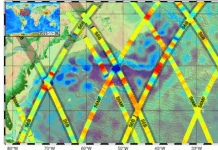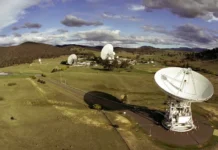NASA’s Digital Information Platform: Revolutionizing Air Traffic Management for the Future
Imagine your smartphone’s navigation app, which quickly analyzes various sources to suggest the best route to your destination. Now, picture a similar system but designed for the aviation industry. NASA has developed such a resource to assist air traffic managers in efficiently guiding airplanes through the skies. This new technology could significantly reduce delays, save fuel, and make air travel more efficient.
Introducing the Digital Information Platform (DIP)
Named the Digital Information Platform (DIP), this innovative database collects and processes crucial data from flight participants such as airlines and drone operators. The platform supports various decision-making tools, aiming to enhance the efficiency of air traffic management. This means quicker, more efficient flights, reducing the time you spend waiting at airports.
Swati Saxena, an aerospace engineer at NASA’s Ames Research Center in California, explains, "Through DIP, we’re also demonstrating how to deliver digital services for aviation users via a modern cloud-based, service-oriented architecture." This statement highlights the platform’s advanced technological framework, which leverages the cloud to provide seamless, real-time data services.
Not Just a Competitor, But a Reference Model
NASA’s objective isn’t to compete with existing systems but to serve as a reference model for the aviation industry. By using DIP as a benchmark, other entities can develop and implement their own platforms and digital services. Saxena adds, "Ultimately, the aviation industry – the Federal Aviation Administration, commercial airlines, flight operators, and even the flying public – will benefit from what we develop." This collaborative approach ensures that all stakeholders in the aviation ecosystem can reap the benefits of improved air traffic management.
Beyond Efficiency: Environmental Benefits
The advantages of DIP extend beyond just saving time. NASA recently collaborated with airlines to demonstrate a traffic management tool that significantly improved traffic flow at select airports. This tool saved thousands of pounds of jet fuel and notably reduced carbon emissions. Such environmental benefits are crucial in today’s context, where sustainability is becoming increasingly important.
Public Access to DIP Data
Much of the data collected in collaboration with airlines is now publicly accessible. Qualified users can create a guest account and access DIP data through a newly created website. This transparency allows for broader participation and innovation within the aviation industry.
A Vision for the Future
NASA envisions a future where American skies are busier than ever, especially during the 2030s and beyond. The current National Airspace System, which includes airports, air navigation facilities, and communication networks, will face challenges in keeping up with this increased demand. DIP is a crucial piece of the puzzle in addressing these challenges.
The vision involves creating a highly automated, safe, and scalable airspace environment. This future scenario includes various types of vehicles and their pilots, as well as air traffic managers, utilizing state-of-the-art automated tools and systems. These tools will provide highly detailed and curated information, leveraging capabilities like machine learning and artificial intelligence to streamline efficiency and manage the anticipated increase in air traffic.
Real-World Implementation and Results
To bring this vision to life, NASA is currently evaluating DIP and its services at several airports in Texas. This initial phase serves as a building block for larger demonstrations in the future. Saxena notes, "These digital services are being used in the live operational environment by our airline partners to improve the efficiency of current airspace operations." The tools are already in use in the Dallas/Fort Worth area and are scheduled to be deployed in the Houston airspace by 2025.
The results so far are promising. In 2022, NASA introduced a machine learning-based tool called Collaborative Digital Departure Rerouting. This tool aims to improve the flow of air traffic and prevent flight delays. It saved more than 24,000 lbs. (10,886 kg.) of fuel by optimizing air traffic in the Dallas area. If such tools were implemented nationwide, the improvements in efficiency, safety, and sustainability would be substantial.
Building a Partnership Ecosystem
The success of DIP and its associated tools is largely due to ongoing collaborations with airlines and the broader aviation industry. "Continued agreements with airlines and the aviation industry led to the creation and expansion of this partnership ecosystem," says Saxena. These partnerships have yielded benefits across the board, demonstrating the value of collaborative efforts in advancing aviation technology.
Conclusion
NASA’s Digital Information Platform represents a significant leap forward in air traffic management. By collecting and processing critical data, DIP offers tools that can save time, reduce fuel consumption, and lower carbon emissions. Public access to this data further encourages innovation and broader participation in the aviation industry. As the skies become busier in the coming decades, DIP will play a crucial role in ensuring safe, efficient, and sustainable air travel.
For those interested in learning more about how NASA’s tools, like the Collaborative Digital Departure Rerouting, use DIP data to provide airlines with routing options, similar to how drivers use cellphone apps for navigation, visit NASA’s official page.
By staying informed about these technological advancements, we can better appreciate the efforts to make air travel more efficient and environmentally friendly.
For more Information, Refer to this article.


































